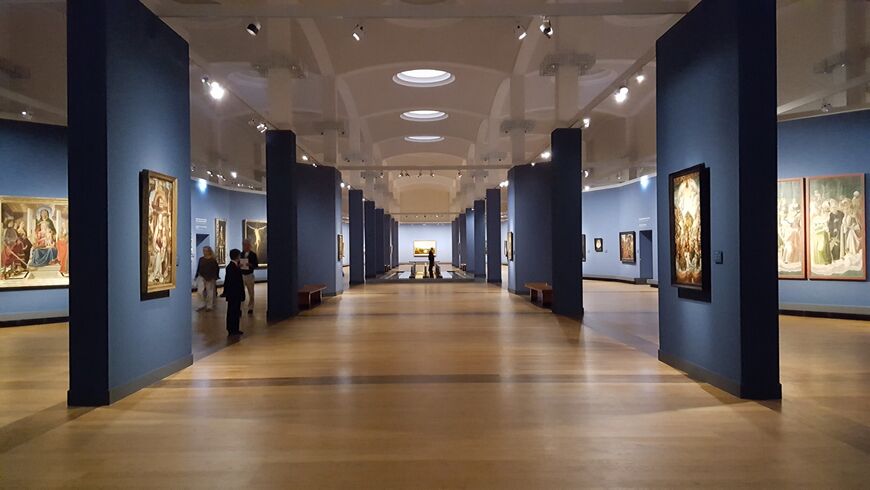Berlin Art Gallery (Berliner Gemäldegalerie)

It is one of Europe's leading art museums. The gallery is located in the building of the Cultural Forum, close to Potsdamer Platz in Berlin. The Berlin Picture Gallery was originally opened in the Royal Museum by the Lustgarten Park, in what is now the Old Museum, and was the first collection of the Museum Island. With its opening in 1830 the whole history of museums in Berlin began.
The core of the museum's collection consists of collections of art from the Electors and Friedrich the Great (Friedrich der Große) in the 17th and 18th centuries. The Berlin Picture Gallery presents more than 1,500 paintings on a total area of 2,200 square metres. The Berlin Art Gallery became internationally renowned thanks to its long-time director, the art historian Wilhelm von Bode. Von Bode not only had an excellent knowledge of all areas of art, but also the necessary connections in professional circles and in high society that enabled him to make significant acquisitions for the museum.
As a result, the holdings of the Berlin Art Gallery became some of the finest in the world, with an almost complete collection of European paintings from the 13th century onwards. In 1904 the gallery became cramped within the walls of the old museum and moved to the Kaiser Friedrich-Museum, now the Bode-Museum, as the new museum on Museum Island was conceived as a Renaissance museum. During World War II, the museum was destroyed and more than 400 paintings were burnt. Parts of the collection were housed in various museums.
In 1998 the Berlin Art Gallery moved into a new building on the Kulturforum. This building was specially designed for the gallery, the two parts of which reunited with the reunification of Germany. Eventually, however, the gallery will move into the Bode Museum building. Part of the art gallery's collection is already housed there. The new Cultural Forum has a semi-circular form. In the centre of the building there is a foyer with two rows of columns, a flat vault and glass domes, decorated with a fountain by the American sculptor Walter De Maria.
A tour of the Berlin Art Gallery takes you through 72 halls and rooms, stretching over two kilometres. All sections are arranged chronologically according to the order in which the works were painted and grouped according to the schools of painting. In other words, the Berlin Art Gallery is a unique visual encyclopaedia of art history.
Works presented
The gallery's collection is based on German and Italian paintings from the 13th to 16th centuries as well as Dutch paintings from the 15th and 16th centuries. The Berlin Picture Gallery presents works by the great Italian painters Giotto di Bondone, Tiziano Vecellio, Fra Beato Angelico, Raffaello Sanzio and old German masters such as Lucas Cranach der Ältere, Konrad Witz, Albrecht Dürer, Hans Holbein der Jüngere, Hans Baldung Grien, the Flemish masters Jan van Eyck and the richly detailed paintings of Pieter Bruegel de Oude.
Rembrandt's works is dedicated to in the museum's central hall. And not by chance — the 16 paintings by the master displayed here are considered some of Rembrandt's most important works. The halls of the Berlin Art Gallery contain around a thousand masterpieces of world art.
Here is just a small list of examples:
- "Amor Vincit Omnia" by Michelangelo Merisi da Caravaggio;
- "Etienne Chevalier with St. Stephen" by Jean Fouquet;
- "Mozes en de tafelen der wet" by Rembrandt Harmenszoon van Rijn;
- "Portrait of Simonetta Vespucci" by Piero di Cosimo;
- "Portrait of Giuliano de' Medici" by Sandro Botticelli;
- "Netherlandish Proverbs" by Pieter Bruegel the Elder;
- "John of Patmos" by Hieronymus Bosch;
- "Portrait of Hieronymus Holzschuher" and "Portrait of a Young Venetian Woman" by Albrecht Dürer;
- "The Arnolfini Portrait" by Jan van Eyck;
- "Portrait of Ugolino Martelli" by Agnolo Bronzino;
- "Nurse with child" by Frans Hals;
- "Portrait of Georg Giese" by Hans Holbein the Younger;
- "Portrait of Isabella Brant" by Peter Paul Rubens.
Part of the collection of the Berlin Art Gallery is housed in the Bode Museum — 150 paintings by the great masters of painting are on display here. The masterpieces in the Bode Museum Gallery include works by Van Eyck, Rembrandt, Botticelli, Dürer and other masters. For orientation, visitors are provided with catalogues and an audio guide — in German and English.
Opening hours
The Berlin Art Gallery is open every day except Monday:
Tuesday, Wednesday, Thursday, Friday — 10 a.m. to 6 p.m.;
Saturday, Sunday — 11 a.m. to 6 p.m..
The gallery's special opening hours on public holidays can be viewed here.
